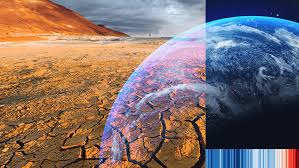ISLAMABAD, JULY17: Cities in Pakistan are warming by 5–6 degrees, Global weather patterns are greatly impacted by climate change, leading to a variety of disruptions and extreme weather events. The University of Maryland has released a new interactive map that illustrates how climate change is changing our globe and how it will likely get worse as more greenhouse gases are released into the atmosphere.
The spatial ecologist at the university, Matthew Fitzpatrick, made the map, which is titled “Future Urban Climates.” It provides an explanation of how cities will feel in 60 years using sophisticated modeling for thousands of cities, towns, and suburbs worldwide.
“Cities in the northern hemisphere will resemble cities in the south much more in 50 years. Regarding the climate that is approaching you, everything is heading towards the equator, Mr. Fitzpatrick stated.
The map shows a bleak picture of 2080 and contains data for almost 40,000 sites worldwide. A search for Lahore indicates that the summer of 2080 is expected to be 21.2% wetter and 4.7 degrees Celsius warmer than the current one. The average temperature in winter may increase by 5.2 degrees Celsius and experience 16.1% more precipitation.
The chart indicates that summers in Karachi might be 18.2% drier and 3.3 degrees Celsius warmer. It is predicted that winters will be 0.4% wetter and 5 degrees Celsius warmer. Recent extreme heatwaves that the city experienced serve as a warning of the dangers posed by climate change.
By 2080, Peshawar’s summers should be 4.5% drier and 5.8 degrees Celsius warmer. The winters would be 9.2% wetter and 5.5 degrees Celsius warmer. Sibbi’s current climate is similar to that of Peshawar in the future.
When we include more cities in this research, we find that the summers in Islamabad are expected to be 4% drier and 5.1 degrees Celsius warmer. The winters would be 11.3% wetter and 5.4 degrees Celsius warmer. Conditions in Islamabad in the future will be similar to those in Mirpur, Azad Kashmir, at the moment.
Summers in Quetta might be 5.5% warmer and 10.3% wetter than winters, which would be 5.5% warmer and 2.1% drier. The current climate in Jalalabad, Afghanistan, is similar to that of Quetta’s projected weather.
By 2080, Bahawalpur’s summers should be 17.3% wetter and 4.9 degrees Celsius warmer. It is predicted that winters will be 7.1% wetter and 5.7 degrees Celsius warmer. Areas with similar weather patterns now have conditions similar to those of Bahawalpur in the future.
By 2080, the summers in Faisalabad should be 22.1% wetter and 5.6 degrees Celsius warmer. It is predicted that winters will be 15% wetter and 5.6 degrees Celsius warmer. The weather of Chowki Jamali, Balochistan, right now can be compared to that of Faisalabad in the future. Globally, New York is expected to resemble the northern part of Mississippi today. It’s predicted that Washington, DC, will feel like North Louisiana right now, with a possible 6 degree Celsius spike in temperature.
